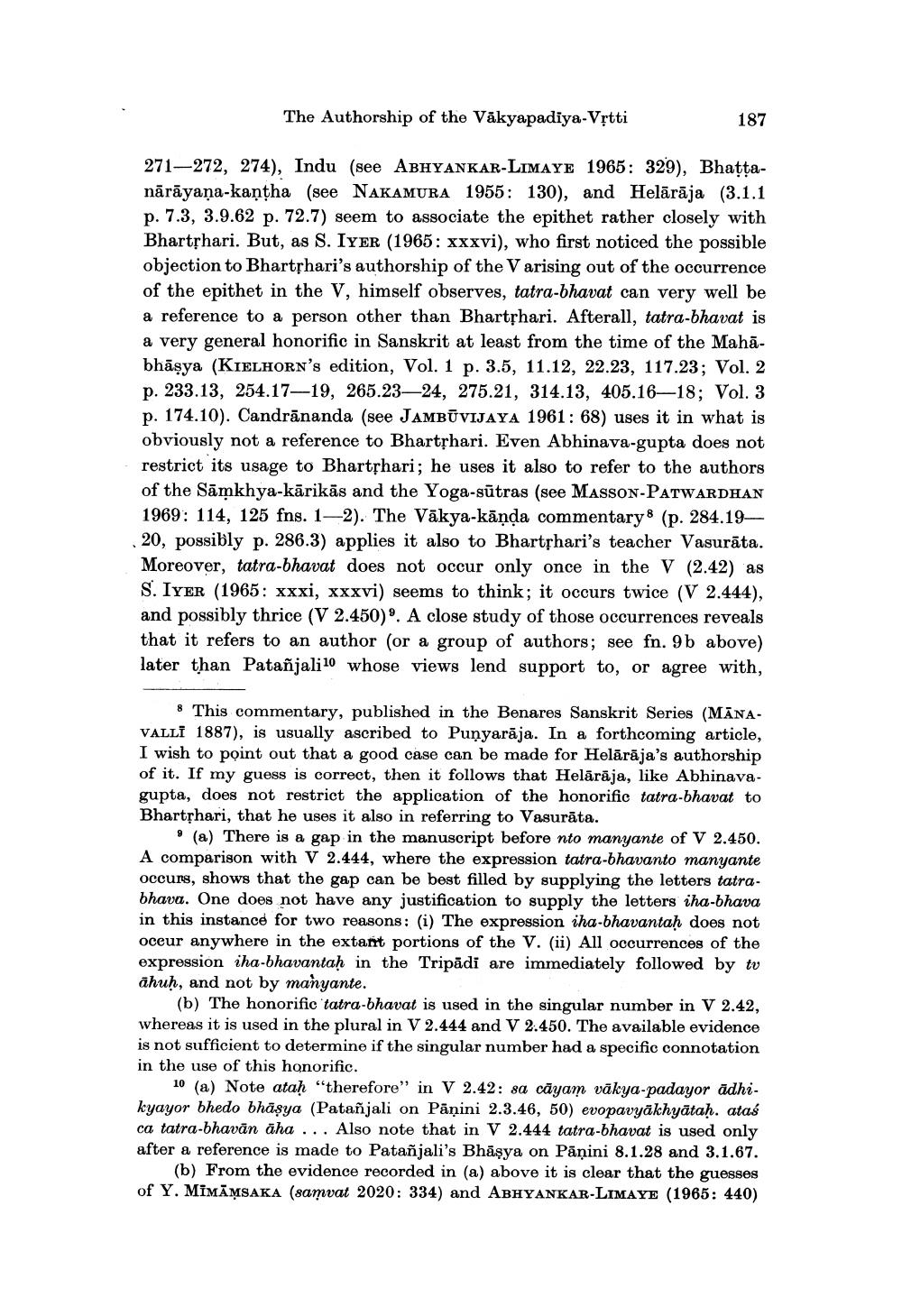Book Title: Authorship Of Vakyapadiya Vrtti Author(s): Ashok Aklujkar Publisher: Ashok Aklujkar View full book textPage 7
________________ The Authorship of the Vākyapadiya-Vrtti 187 271—272, 274), Indu (see ABHYANKAR-LIMAYE 1965: 329), Bhattanārāyaṇa-kantha (see NAKAMURA 1955: 130), and Helārāja (3.1.1 p. 7.3, 3.9.62 p. 72.7) seem to associate the epithet rather closely with Bhartphari. But, as S. IYER (1965: xxxvi), who first noticed the possible objection to Bhartrhari's authorship of the V arising out of the occurrence of the epithet in the V, himself observes, tatra-bhavat can very well be a reference to a person other than Bhartphari. Afterall, tatra-bhavat is a very general honorific in Sanskrit at least from the time of the Mahābhāsya (KIELHORN's edition, Vol. 1 p. 3.5, 11.12, 22.23, 117.23; Vol. 2 p. 233.13, 254.17—19, 265.23—24, 275.21, 314.13, 405.16–18; Vol. 3 p. 174.10). Candrānanda (see JAMBŪVIJAYA 1961: 68) uses it in what is obviously not a reference to Bhartshari. Even Abhinava-gupta does not restrict its usage to Bhartshari; he uses it also to refer to the authors of the Sāmkhya-kārikās and the Yoga-sūtras (see MASSON-PATWARDHAN 1969: 114, 125 fns. 1—2). The Vākya-kāņda commentary & (p. 284.19 20, possibly p. 286.3) applies it also to Bhartshari's teacher Vasurāta. Moreover, tatra-bhavat does not occur only once in the V (2.42) as S. IYER (1965: xxxi, xxxvi) seems to think; it occurs twice (V 2.444), and possibly thrice (V 2.450)'. A close study of those occurrences reveals that it refers to an author (or a group of authors; see fn. 9b above) later than Patañjali 10 whose views lend support to, or agree with, I amy reis restricte che taomlication of the 8 This commentary, published in the Benares Sanskrit Series (MĀNA. VALLI 1887), is usually ascribed to Punyarāja. In a forthcoming article, I wish to point out that a good case can be made for Helārāja's authorship of it. If my guess is correct, then it follows that Heläräja, like Abhinavagupta, does not restrict the application of the honorific tatra-bhavat to Bhartphari, that he uses it also in referring to Vasurāta. . (a) There is a gap in the manuscript before nto manyante of V 2.450. A comparison with V 2.444, where the expression tatra-bhavanto manyante occurs, shows that the gap can be best filled by supplying the letters tatrabhava. One does not have any justification to supply the letters iha-bhava in this instance for two reasons: (i) The expression iha-bhavantah does not oceur anywhere in the extant portions of the V. (ii) All occurrences of the expression iha-bhavantah in the Tripādi are immediately followed by tv āhuḥ, and not by manyante. (b) The honorific tatra-bhavat is used in the singular number in V 2.42, whereas it is used in the plural in V 2.444 and V 2.450. The available evidence is not sufficient to determine if the singular number had a specific connotation in the use of this honorific. 10 (a) Note atah "therefore" in V 2.42: sa cāyam väkya-padayor ādhikyayor bhedo bhäşya (Patañjali on Pāṇini 2.3.46, 50) evopavyākhyātaḥ. atas ca tatra-bhavän äha ... Also note that in V 2.444 tatra-bhavat is used only after a reference is made to Patañjali's Bhāşya on Pāņini 8.1.28 and 3.1.67. (b) From the evidence recorded in (a) above it is clear that the guesses of Y. MIMĀMSAKA (samvat 2020: 334) and ABHYANKAR-LIMAYE (1965: 440)Page Navigation
1 ... 5 6 7 8 9 10 11 12 13 14 15 16 17 18
